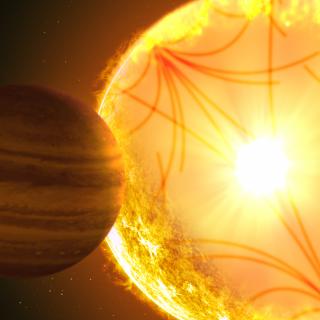Bibcode
Nascimbeni, V.; Borsato, L.; Leonardi, P.; Sousa, S. G.; Wilson, T. G.; Fortier, A.; Heitzmann, A.; Mantovan, G.; Luque, R.; Zingales, T.; Piotto, G.; Alibert, Y.; Alonso, R.; Bárczy, T.; Barrado Navascues, D.; Barros, S. C. C.; Baumjohann, W.; Beck, T.; Benz, W.; Billot, N.; Biondi, F.; Brandeker, A.; Broeg, C.; Busch, M. -D.; Collier Cameron, A.; Correia, A. C. M.; Csizmadia, Sz.; Cubillos, P. E.; Davies, M. B.; Deleuil, M.; Deline, A.; Delrez, L.; Demangeon, O. D. S.; Demory, B. -O.; Derekas, A.; Edwards, B.; Ehrenreich, D.; Erikson, A.; Fossati, L.; Fridlund, M.; Gandolfi, D.; Gazeas, K.; Gillon, M.; Güdel, M.; Günther, M. N.; Helling, Ch.; Isaak, K. G.; Kerschbaum, F.; Kiss, L. L.; Korth, J.; Lam, K. W. F.; Laskar, J.; Lecavelier des Etangs, A.; Leleu, A.; Lendl, M.; Magrin, D.; Maxted, P. F. L.; Merín, B.; Mordasini, C.; Olofsson, G.; Ottensamer, R.; Pagano, I.; Pallé, E.; Peter, G.; Pollacco, D.; Queloz, D.; Ragazzoni, R.; Rando, N.; Rauer, H.; Ribas, I.; Santos, N. C.; Scandariato, G.; Ségransan, D.; Simon, A. E.; Smith, A. M. S.; Southworth, R.; Stalport, M.; Sulis, S.; Szabó, Gy. M.; Udry, S.; Ulmer, B.; Van Grootel, V.; Venturini, J.; Villaver, E.; Walton, N. A.
Bibliographical reference
Astronomy and Astrophysics
Advertised on:
10
2024
Journal
Citations
7
Refereed citations
5
Description
The planetary system K2-24 is composed of two transiting low-density Neptunians locked in an almost perfect 2:1 resonance and showing large transit time variations (TTVs), and it is an excellent laboratory to search for signatures of planetary migration. Previous studies performed with K2, Spitzer, and RV data tentatively claimed a significant non-zero eccentricity for one or both planets, possibly high enough to challenge the scenario of pure disk migration through resonant capture. With 13 new CHEOPS light curves (seven of planet b, six of planet c), we carried out a global photometric and dynamical re-analysis by including all the available literature data as well. We obtained the most accurate set of planetary parameters to date for the K2-24 system, including radii and masses at 1% and 5% precision (now essentially limited by the uncertainty on stellar parameters) and non-zero eccentricities eb = 0.0498‑0.0018+0.0011, ec = 0.0282‑0.0007+0.0003 detected at very high significance for both planets. Such relatively large values imply the need for an additional physical mechanism of eccentricity excitation during or after the migration stage. Also, while the accuracy of the previous TTV model had drifted by up to 0.5 days at the current time, we constrained the orbital solution firmly enough to predict the forthcoming transits for the next ~15 years, thus enabling efficient follow-up with top-level facilities such as JWST or ESPRESSO.
Related projects

Helio and Astero-Seismology and Exoplanets Search
The principal objectives of this project are: 1) to study the structure and dynamics of the solar interior, 2) to extend this study to other stars, 3) to search for extrasolar planets using photometric methods (primarily by transits of their host stars) and their characterization (using radial velocity information) and 4) the study of the planetary
Savita
Mathur

Exoplanets and Astrobiology
The search for life in the universe has been driven by recent discoveries of planets around other stars (known as exoplanets), becoming one of the most active fields in modern astrophysics. The growing number of new exoplanets discovered in recent years and the recent advance on the study of their atmospheres are not only providing new valuable
Enric
Pallé Bago